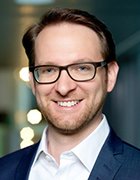
Getty Images/iStockphoto
Saueressig: SAP's future is multi-tenant SaaS ERP
SAP's Thomas Saueressig explains the future of multi-tenant cloud ERP for SAP customers and why it will take some large companies longer to get there.
SAP's product future lies in multi-tenant SaaS ERP, according to Thomas Saueressig, head of SAP product engineering.
Saueressig, a longtime SAP employee, has been at the heart of the company's inevitable but challenging move to become a cloud-centric organization. As CIO from 2016 to 2019, Saueressig oversaw the company's own efforts to undergo a digital transformation.
In part one of the Q&A, Saueressig focuses on S/4HANA Cloud and how it can be the center of customers' efforts to change business models and processes.
Here, Saueressig discusses why most SAP customers are headed for a multi-tenant SaaS future, why that journey will take longer for some and how his experience as SAP's CIO has provided lessons learned for how he approaches his current position.
Do you think all SAP customers will eventually move to multi-tenant SaaS ERP and related business applications like SuccessFactors? And if not, why not?
Thomas Saueressig: For line-of-business applications, we clearly see that our customers have embraced a public cloud SaaS solution. That's not a debate. The only differentiator, which we absolutely see, is the notion of the core ERP, if you think about finance and manufacturing, which are in S/4HANA core. The reality is some large enterprises with decades of implementation and continuous evolvement of the product and modifications will eventually be in a fully SaaS ERP, but that moment will be when they are able to do standardization and change the business processes, and that may be very long out for some.
What did you learn in your time as SAP CIO about implementing a cloud-first model? What are some of the key lessons that you can share with SAP customers who are trying to do the same?
 Thomas Saueressig
Thomas Saueressig
Saueressig: The reality of every large enterprise is they have existing complex enterprise architectures with thousands of applications that are playing together and have been integrated over years. So how can you work on structural transformation projects, which perhaps have a one- to three-year time horizon, versus being able to have quick wins on a weekly basis?
[You need to put in place] an agile architecture, because every CIO needs to show progress, they need to show success, they need to show how they helped the [cloud] transformation. This means that you need to be able to have a multitude of project horizons, which you need to be able to facilitate. What we did at SAP, for example, was we implemented all our [line-of-business] cloud solutions right away, which was a relatively quick win. We also went to upgrade to the latest version of S/4HANA, which was a longer time frame, about a year. But in parallel, based on the SAP Business Technology Platform, we rolled out 400 cloud applications, which we enabled on mobile devices so that our employees had a different working environment.
You have the cloud properties that SAP has acquired in your portfolio -- SAP CEO Christian Klein said that integrating them was one of his priorities. How is that integration going?
Saueressig: It's actually very good. We have 450 integration scenarios we delivered last year alone. We will continue this, but also what's very important is that we provide open APIs, because we want to have an open ecosystem. We now have over 3,000 APIs available to our customers for applications. We're not only talking about cloud-to-cloud integration for our products, but also to have hybrid integration scenarios. So you now see the same amount for S/4HANA APIs for integrations to the on-premises and private cloud version. The interesting piece with integration is that there's always more to do because there are more scenarios and more cross processes we want to enable.
In the next year or two, are there any new directions SAP might go in for business applications? Maybe areas that you haven't been in before or haven't had such a big portfolio in?
Saueressig: First, we want to evolve this intelligent enterprise vision for integrated enterprise operations into a network of intelligent enterprises. [This uses] the SAP Business Network with all the trading partners to have multi-enterprise business collaboration and fundamentally talk about cross-enterprise integrations -- not just from S/4HANA to SAP Ariba, but to integrate the Ariba system to the CX [customer experience] systems of other customers and have these end-to-end chains of integrations across companies.
The second topic is sustainability. We absolutely believe that if you want to seriously tackle sustainability, on one hand you need a broad portfolio, because ESG [environmental, social and governance] is not just about the environmental aspects. It also includes the societal aspects like diversity and inclusion in HR, ethical sourcing and procurement, but also the deep topics of the supply chain. For example, the carbon footprint in Scope 3 emissions is a more relevant factor than your own operation, and that's why it's so important to have the entire supply chain lined up. That's also one of the key aspects that we are working on to enable the circular economy at scale. Today in the GDP, only 9% of companies are part of a circular economy, and that needs to increase.
Editor's note: This interview has been edited for clarity and brevity.
David Essex is an industry editor in the Enterprise Software and Services Media Group at TechTarget.
Jim O'Donnell is a TechTarget senior news writer who covers ERP and other enterprise applications for SearchSAP and SearchERP.





